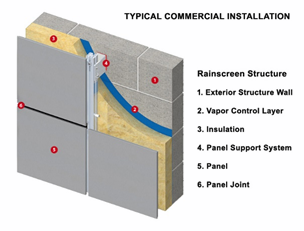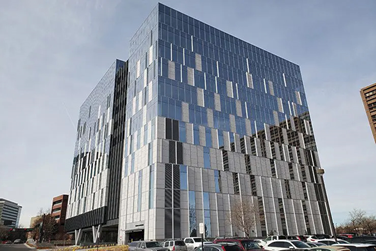Rainscreen cladding is an innovative exterior cladding system that can elevate the performance, aesthetics, and durability of commercial and residential construction projects. It provides effective protection against the elements while enhancing energy efficiency.
Rainscreen design incorporates an outer cladding layer and an inner weather-resistant barrier separated by an air gap to prevent moisture infiltration and promote natural ventilation. The insulating properties provided by the air gap improve thermal performance, to contribute to reduced heating and cooling costs. This combination of moisture management, durability, and energy efficiency aligns with modern construction principles, to make rainscreen cladding systems a compelling high-performance option for architects, engineers, and builders.
What is Rainscreen Cladding?
A wide variety of cladding materials can be incorporated into a rainscreen cladding system, including glass, stone, hardwood, metal, brick and composite siding materials.
What sets the system apart from other cladding options is the structured application of cladding that produces an air gap between these layers. The air gap, or cavity, is established with either a metal racking system for applying cladding panels, or the use of wood furring strips, over which the exterior siding can be installed.

Benefits of Rainscreen Cladding
With rainscreen cladding, innovation meets performance to create structures that are as resilient as they are sustainable. Rainscreen cladding has been used in other parts of the world for more than a century. This architectural concept is finding new traction in North America due to the versatility and performance benefits these systems provide.
From a more resilient building envelope to potential energy savings and improved indoor comfort, this approach aligns with modern construction trends focused on both performance and aesthetics.
Thermal Performance
Beyond the protective capabilities of rainscreen cladding is impressive thermal performance. The strategic air gap within the system serves as an additional layer of insulation, to effectively reduce heat transfer between the exterior and interior of a building. This insulating effect helps regulate indoor temperatures, minimizes heat loss during colder months, and heat gain during warmer periods. By enhancing the building's energy efficiency, rainscreen cladding contributes to reduced energy consumption for heating and cooling, thereby lowering operational costs and environmental impact.
Moisture Management
Rainscreen systems not only protect structures from the effects of rain, wind, and temperature fluctuations, but they also allow structures to “breathe.” Rainscreen systems manage moisture effectively, preventing it from seeping into the structure while simultaneously allowing moisture in the cavity to evaporate effectively. This is crucial for preventing mold growth and maintaining a dry, healthy indoor environment.
A rainscreen system is comprised of key structural components that work together in order to achieve effective moisture management, including:
Outer Cladding Material
The outer cladding shields the building from direct exposure to environmental elements, and acts as the first line of defense against moisture.
Air Gap or Cavity
The cavity provides a buffer zone that prevents moisture from reaching the inner layers of the building, along with natural ventilation and drainage, to facilitate the evaporation of any moisture that penetrates the outer cladding.
Weather-Resistant Barrier
The weather-resistant barrier is applied directly to the building's structural wall and acts as a secondary line of defense against moisture infiltration.
Ventilation Openings
Openings are strategically positioned within the rainscreen system to facilitate the circulation of air. Ventilation helps in the evaporation process, and helps to maintain a dry environment within the cavity.
Structural Protection
A rainscreen system acts as a comprehensive shield that safeguards the integrity of a building, and provides robust structural protection by creating a multi-layered defense against environmental elements. Rainscreen cladding systems deliver these protective design benefits:
Impact Resistance
Depending on the cladding material chosen, a rainscreen system can provide impact resistance against various external forces, such as hail or wind-blown debris.
Longevity and Durability
By managing moisture, promoting ventilation, and enhancing thermal insulation, a rainscreen system enhances the overall longevity and durability of the building.
Maintenance Reduction
Rainscreen cladding has moisture management properties that help minimize efflorescence (salt deposits), and protect the structure from the corrosive properties of salts, and the resulting staining on exterior surfaces. This contributes to a cleaner and more aesthetically pleasing appearance over time.
Aesthetic Versatility
Rainscreen cladding offers unparalleled architectural versatility that allows architects and designers to realize a broad spectrum of creative interpretation. Design professionals and building owners can explore diverse materials such as metal, glass, wood, concrete, terra cotta, brick, and even innovative composites designed with the appearance of natural stone. Each type of material presents a distinct visual and tactile experience, and can create façades that range from modernist to rustic; from minimalist to ornate. This versatility empowers architects to align their design choices with the building's purpose, context, and desired aesthetic impact.
Cladding panels can be installed vertically, horizontally, or even diagonally, for dynamic visual effects that capture light and shadow. The system accommodates modular arrangements, irregular shapes, and bold patterns, to foster limitless design possibilities that challenge traditional building norms.
Additionally, rainscreen cladding can seamlessly integrate with other architectural elements. It complements glass curtain walls, traditional masonry, and structural features, for a cohesive design language across the building envelope.
Rainscreen Cladding Applications

Rainscreen cladding offers diverse applications across the architectural landscape. Some key applications include:
Commercial Buildings
Rainscreen cladding can enhance the façades of office complexes, retail centers, and mixed-use buildings. It provides a polished, modern appearance that attracts tenants and customers while also contributing to energy efficiency.
Residential Developments
From high-rise condominiums to suburban housing, rainscreen cladding elevates the visual appeal of residential structures, by offering architects a versatile palette to create striking exteriors.
Educational Institutions
Rainscreen cladding can be integrated into school and university buildings, to provide cost savings both from the perspective of lower cost construction materials, and energy savings through long-term thermal performance.
Healthcare Facilities
Hospitals and medical centers can benefit from rainscreen cladding's durability and moisture resistance, and lower exterior maintenance costs.
Hospitality Industry
Hotels and resorts utilize rainscreen cladding to create inviting exteriors that blend with their surroundings while maintaining a distinct style and brand identity.
Cultural and Civic Centers
Museums, theaters, and government buildings can benefit from rainscreen cladding's aesthetic flexibility that allows architects to design structures that harmonize with the cultural and civic importance of the spaces.
Typical details of rainscreen applications for both residential and commercial projects, with a range of possible claddings, can be viewed at this link, courtesy of the Rainscreen Association in North America (RAiNA).
Rainscreen Cladding Case Studies

The J. Edgar Monroe Memorial Science Building at Loyola University New Orleans, constructed in 1969, originally featured a futuristic Post-Modern fiberglass façade that, over time, became an architectural oddity on campus. As part of a campus renovation, plans emerged for a 114,000- square-foot expansion and exterior update to harmonize with the traditional brick structures on campus.
The initial proposal for a high-performance terracotta panel façade faced budget constraints, which led to the exploration of alternatives. Telling Architectural’s Corium® brick rainscreen system was the solution that offered both performance and aesthetic attributes. The system's weight advantage and cost-effectiveness appealed to the project stakeholders. The system's proven performance in challenging climates won over engineering consultants and contractors alike.
The system allows up to five inches of continuous insulation and an uninterrupted air/moisture barrier, providing the opportunity to maximize thermal performance and resolve the building's energy efficiency challenges.

Denver's 50 FIFTY Building exemplifies contemporary aesthetics through rainscreen cladding. A 12-story tower with AAA office space, it stands out for its quality materials and finishes. Granite played a crucial role in the 185,000 sq. ft. structure, with Sierra White® stone selected for the rainscreen cladding.
Its consistent appearance aligned with the modern design. Coldspring assisted with granite selection, including Mesabi Black® stone accentuated light wells. While rainscreen systems can be constructed with cost-saving objectives and simple siding, systems also provide the opportunity for extremely high-end design elements, such as natural stone or custom glass. The outcome is an intricately designed office building, a testament to elegance and superior craftsmanship.
Find Outstanding Rainscreen Cladding with Acelab
Acelab is a cloud-based collaboration platform that offers a range of tools and resources to help architecture professionals research, compare and select building products for their projects. With Acelab, users can access product data, technical specifications, and CAD details from leading manufacturers, as well as tools to create and manage project libraries, product lists, and specification documents. Acelab is designed to help architecture professionals save time and streamline their workflows by providing a centralized source of information and tools for building product research and specification tasks.
Schedule a demo today to see what Acelabs can do for you and your team!

